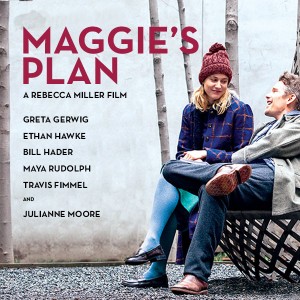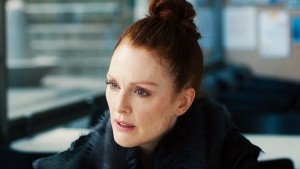Interview: Writer/Director Rebecca Miller of “Maggie’s Plan”
Posted on May 10, 2016 at 3:32 pm

Let’s talk about the hair in the movie, there’s a lot of very interesting hair.
Yes! It’s true, it’s true. I remember fluffing up Bill Hader’s hair myself. I was like, “It’s not fluffy enough; it has to be like this.” It needed to be fluffy, because it’s a little bit based on a friend of mine who had fluffy hair before he lost all of it.
And Julianne Moore’s character had that very severe pulled up hair.
Yeah well that was Julianne’s idea; she said, “I really think it as to be wound up on the top of my head.” I thought it worked great, I mean it looks like there was some other little person In that bun. Actually I remember having a discussion like, “Do you think maybe we should have a moment where the hair comes down like after when she wakes up in the morning and she’s living it with Maggie.” And she said, “I think it should kind of slide off to the side.”
And her costumes are wonderfully tactile.
Malgosia Turzanska is a Polish designer. She’s a wonderful costume designer and she started talking a lot about fur, cracked ice, textures. Julianne wanted a uniform. Like something that was the same silhouette basically like all the time. She liked these boots, I forget what they are called but there is a certain brand of boots which are clogs and people wear them a lot in New York right now. She had them specially made into long boots so that there was sort of some heaviness to the shoe and kind of toughness to it but also elegance to these long things that go over jeans and then the tunic and then the fur vest because I wanted her to be like a Viking queen.
One thing I that I always love in movies and plays is when some of the characters speak a language that another character doesn’t speak, as Maggie’s stepchildren do in this film.
I just like the idea that they have their secret language that Maggie can’t penetrate. It’s just one more thing that isolates her in away in this family that she’s trying to be a part of or create, but also connects them to their mother.
You were an actress before you did what you’re doing now. Was that what made you want to direct?
I actually knew I wanted to be director before I started acting. In a weird way I fell into acting for various reasons but before I started acting I was making films that were really what we would now call video installations. I mean I was shooting on film and they were more connected to visual art and to painting. I started to act in films partly because I thought I had an opportunity to make money to make these sculptures I wanted to make. It began as a sort of lark and I then ended up working with all these wonderful directors. I started being able to imagine myself on a bigger set to understand how sets work, to understand how movies are really made because I was a painter, I didn’t know. So that really expanded my imagination and also I started to think I would love to make art that wasn’t so glorified, that was for everybody, more populist. So that how I started thinking about it.
The directors that I worked with were so wonderful. Mike Nichols was one of the great directors who I actually got to talk to a lot about this film before he died and was a kind of mentor on this film. I’ve studied and loved his work for years. His first film, “Who’s Afraid of Virginia Woolf,” is just one of the greatest films of the 20th century and then “The Graduate” and “Carnal Knowledge” and so on. So I got to work with him as an actress but I would have lunch with him and talk to him. I would talk to him a lot about pace and I would just listen to him. Pacing is very important to him and he was very open with actors. He didn’t try to cordon himself off from actors. He wasn’t afraid of actors. A lot of directors don’t really like actors that much and would prefer not to get down and not to kind of intermingle too much whereas I think Mike really loved actors. He treasured them and I’m more on that side of the fence. I really like working with actors. I really like that collaboration. I could just write books if I only want to control everything. Which I do. I do write books. But I could only write books. If I didn’t like the chaos of not knowing and being surprised then I wouldn’t make films because actors bring in the surprise element. All acting is improvisation and word wise very little of my work is in improvisation but to me every moment of interpretation is a kind of improvisation because it’s coming out directly out of the actor as a surprise.
You work with three of my favourite actors as your leads and all of them are writers too.
I certainly didn’t go out looking for a bunch of writers who were actors but at the same time I don’t think it was an accident that out of all this group of people, Greta, Ethan, but also Bill Hader, Maya Rudolph were all writers and Julianne writes also. So they’re all writers and serious writers and I think there’s just something about the way they transmit their minds, especially the leads who I had worked with really for a long time, like a year before we shot. They had really good ideas and questions that let me tailor the script to them. For example Julianne said, “I really think we need to see her working. We need to see her in an academic environment.” I answered that with that auditorium scene which is really a fun scene and that wouldn’t have happened if she hadn’t said that. I wasn’t going to get to know Georgette until later and then seeing her teach was such a great idea.
Another thing that I like about the movie is that you’ve made a movie that was so fearless about smart people who are engaged deeply with ideas.
I’ve never dumbed down one single moment in the movie because I feel like people like to think and have fun at the same time.
You had a great control over the tone of the film, with a slightly heightened slightly bubbly feeling. What creates that?
It’s a strange mystery. I don’t know how you describe how you do that. It is a combination of all those things and it’s the main job of the director. It starts with the script with the tone of the jokes, the slightly absurd quality to the whole thing. I mean in a way there is a whole absurdity to the whole set-up that already lifts it up off the ground then this is where using very talented actors comes in. It’s almost like a tuning fork, they hear each other and they feel each other. They know what movie they are in according to the signs and the scripts. Partly through direction pushing them one way or another but really they have to come in knowing.
That’s why you want to rehearse a little bit but not too much before. I love to work with actors a long time before on just character, building character, not necessarily saying the words because you want freshness there when you shoot. And then there’s the design. What color are the walls? What color is the jacket next to the wall? How do you create a world that’s just that little bit heightened, as you say? What color choice might be just a little bit more than what you might see in everyday life but yet still real, real enough? And the emotion I insist is completely real. So everybody is really emotional. These are very real problems that real people have. Everyone goes just a little bit further than most people would. You know it’s like a path we know to be our own. The actors go just that much further along that path.
